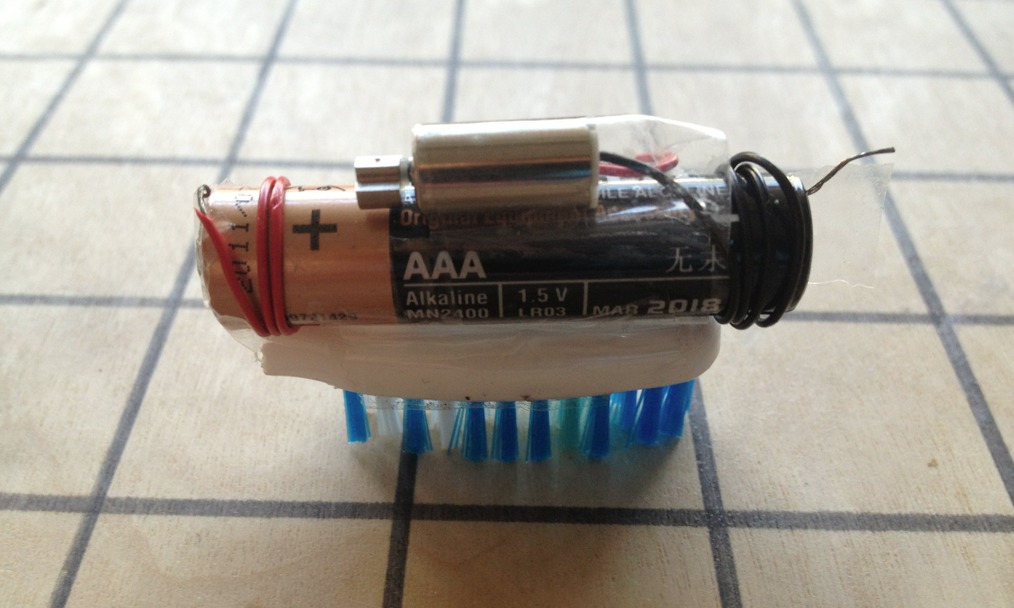Make an electronic toy
Build a simple battery-powered electronic toy with LED, motor, switch, and safe snap connectors, learning basic circuits and creative decoration.



Step-by-step guide to make a battery-powered electronic toy
How to Make a High Speed DC Motor Car at Home | DIY Powerful Electric Toy Car | Science Project Idea
Step 1
Gather all materials and clear a small workspace where you can build safely.
Step 2
Put the AA batteries into the battery holder and close the holder.
Step 3
Snap a connector wire from the battery holder positive terminal to the slide switch input terminal.
Step 4
Snap a connector wire from the battery holder negative terminal to the motor negative terminal.
Step 5
Snap a connector wire from the slide switch output terminal to the motor positive terminal.
Step 6
Snap a connector wire from the slide switch output terminal to one end of the 220 ohm resistor.
Step 7
Snap a connector wire from the other end of the resistor to the longer leg of the LED (LED positive).
Step 8
Snap a connector wire from the shorter leg of the LED (LED negative) to the battery holder negative terminal.
Step 9
Secure the motor and the LED onto the cardboard or small box using tape or glue so they won’t move.
Step 10
Cut a small cardboard disk or blade shape to make a lightweight propeller.
Step 11
Push the cardboard propeller onto the motor shaft and secure it with a tiny piece of tape.
Step 12
Decorate your toy body with colouring materials to make it look awesome.
Step 13
Flip the slide switch to test that the motor spins and the LED lights.
Step 14
Take a picture of your finished electronic toy and share it on DIY.org
Final steps
You're almost there! Complete all the steps, bring your creation to life, post it, and conquer the challenge!


Help!?
What can I use if I can't find a battery holder, a 220 ohm resistor, or the exact motor/LED listed?
If you don't have an AA battery holder, tape two AA batteries together and attach wires to their terminals, if you lack a 220 Ω resistor use a nearby value like 330 Ω or two 110 Ω in series, and a similar-voltage hobby DC motor and standard LED will substitute for the originals.
The motor doesn’t spin or the LED won’t light when I flip the switch—what should I check?
If the motor won't spin or the LED doesn't light, verify the AA batteries are inserted correctly in the battery holder, that connector wires are snapped to the right terminals (battery positive to switch input, battery negative to motor negative and LED negative, switch output to motor positive and to the resistor then LED positive), and that the LED's longer leg is connected after the resistor and not reversed.
How can I adapt this activity for different ages and skill levels?
For younger children, an adult can pre-attach connector wires and handle the motor and switch while the child tapes the cardboard propeller and decorates the toy, whereas older kids can do the wiring themselves and experiment with soldering or changing resistor values and LED colors.
How can we extend or personalize the electronic toy after building it?
To enhance the toy, try cutting different cardboard propeller shapes to change airflow, replace the slide switch with a potentiometer for variable motor speed, add extra LEDs for decoration, and personalize the toy body with coloring before taking a picture to share on DIY.org.
Watch videos on how to make a battery-powered electronic toy
DIY How To Make a Electric Toy Car - Easy Science Project For KIDS
Facts about basic electronics and circuits for kids
⚙️ Tiny DC motors used in toys can spin thousands of times per minute—many run around 3,000–10,000 RPM!
🛑 A switch simply opens or closes a circuit to instantly stop or start the flow of electricity.
💡 LEDs are super energy-efficient and can last tens of thousands of hours while using very little power.
🧩 Snap connectors and alligator clips let kids build circuits safely and swap parts without soldering.
🔋 The first battery, the Voltaic pile, was invented in 1800 and launched the age of portable electricity.
How do I build a simple battery-powered electronic toy with an LED, motor, switch, and snap connectors?
What materials and tools do I need to make this electronic toy?
What ages is this battery-powered electronic toy activity suitable for?
What safety precautions should I follow when making this electronic toy?


One subscription, many ways to play and learn.
Only $6.99 after trial. No credit card required



